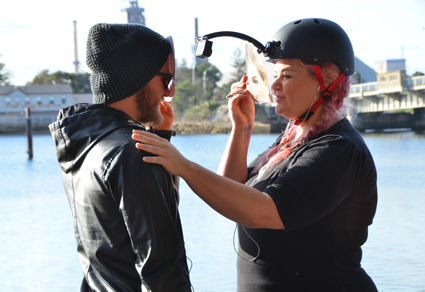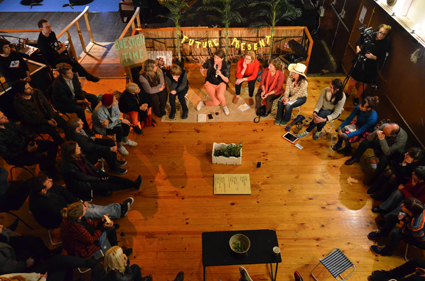Breakdown and repair
Ben Brooker: Vitalstatistix, Adhocracy

Black Market, pvi collective
photo Heath Britton
Black Market, pvi collective
A sense of the breakdown of natural and human-made systems was all-pervading at this year’s Adhocracy, Vitalstatistix’ curated hothouse of new art and performance. It seemed fitting that, as the program enters its fifth year and the company its 30th, this year’s talks, showings and open studios looked both backwards and forwards, each grappling in some way with how the recent past has challenged our species’ capacity to survive and thrive in the years ahead.
Looking backwards: 1984
UK artist and researcher Sophie Hope’s 1984 is an ongoing, global project which uses the dinner party as a format for exploring intersections between art and politics in the year 1984. Aside from George Orwell’s novel, the year seems arbitrary to Australians—Hope was thinking of Margaret Thatcher’s galvanising effect on London’s overtly political artists when she chose it—but the dinner which took place at Adhocracy, curated by Steve Mayhew, nevertheless saw a lively and provocative exchange of ideas between arts workers and a former politician—Ollie Black, Rob Brookman, Eileen Darley, Annie Newmarch and Anne Levy. This iteration marked the first time Hope has permitted one of her dinners to be held in the presence of an audience, a decision that turned out to be providential; an oversight led to the dinner not, as is usual, being audio recorded for Hope’s ultimate use in a radio piece, an installation and a publication. The conversation, which ranged freely and, owing to the frequent replenishment of wine glasses, sometimes intemperately, around issues such as Marxism, the Cold War and gender equality, will live on as memory only, as recollections of recollections.
Heat
In Hissy Fit’s Heat, the notion of the deviant, transgressive woman was investigated through pop culture representations of women in conflict with each other in female prison dramas and B-movies. Into this mix, devisers/performers Emily O’Connor and Natalie Randall also throw the choreography of Greco-Roman wrestling, their three showings combining discussion, video and their own ad hoc demonstrations of the ancient combat sport’s drags, hugs and headlocks. The marriage is a curious one—at this early stage bringing together problematisation of female gender norms with the strongly homoerotic physicality of Greco-Roman wrestling doesn’t suggest an aesthetically or conceptually cohesive whole. The work clearly has a long way to go.
Looking forwards: Black Market
In pvi collective’s Black Market, a worldwide economic collapse has precipitated the rise of a thriving underground trade in bartered goods and services. The participatory, still-developing work cast its audience members as hustlers in this brave new world, mobile phones thrust into our hands to facilitate the exchange of our own goods—pens and pencils, bus tickets, lipstick, Panadol, as well as jokes, hugs and other acts of human solidarity—for unknown but enticing rewards assigned categories including ‘medicine,’ ‘porn,’ ‘courage’ and ‘weaponry.’ Our prices set and earphones installed, we drifted out onto the Port Adelaide waterfront, pvi’s prototype app instructing us on how and where to complete our deals. A bold and playful intervention into the d siscourse around the failure of market economics, Black Market nevertheless posed a nagging question: is iPhone technology, contingent on our current social, economic and technological structures, the most appropriate platform for a work concerned with showing us the effects of the collapse of precisely these structures?
Somatic Drifts
Grounded in horticulture and neuroscience, Cat Jones’ full body experience for one person at a time was an undoubted highlight of this year’s program. Gesturing towards the emergent ontologies of a post-human future, Somatic Drifts sought, through sensory and aural immersion, to radically unsettle the sense of self of participants, who had both human and plant identities progressively imposed over their own through sound, aroma, touch and visual feedback. My initial trepidation was quickly forgotten, the work proving unexpectedly affecting in its therapeutic, closely guided dislocations of sense and self as well as its emotive engagement with ideas around the fostering of empathy between species. Still in its first stage of research and development, the progress of Somatic Drifts will be keenly monitored by this writer.

Future Present
photo Heath Britton
Future Present
Future Present
For many, the weekend culminated in the final session, Future Present: artists, primary industry & climate change, a commissioned, interdisciplinary project led by Rosie Dennis of Urban Theatre Projects. A diverse panel of non-artists (including Federal Member for Port Adelaide, Mark Butler) assembled on Adhocracy’s last, chilly night to share their hopes and fears around an irrevocably climate-changed future. For the previous two weeks, ten local artists had been engaged in a residency that saw them undertake field trips to meet South Australian food producers who, having lived all their lives with the direct impacts of prolonged natural drought, are now on the frontlines of battling anthropogenic climate change. Monday night’s conversation was predictably saturnine, the mood offset only by the panel members’ ironic wearing of colourful leis. It felt good to talk, to find ourselves if not hopeful then at least happy while in the fraternal presence of artists and non-artists alike who grasp that the way forwards may necessarily entail the way back, back from the brink, back to the people and the earth.
Vitalstatistix, Adhocracy, curators Paul Gazzola, Jason Sweeney, Lara Torr, Emma Webb, Waterside Workers Hall, Port Adelaide, 7-9 June
RealTime issue #122 Aug-Sept 2014 pg. 44






